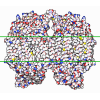+ データを開く
データを開く
- 基本情報
基本情報
| 登録情報 | データベース: PDB / ID: 8b6j | |||||||||||||||
|---|---|---|---|---|---|---|---|---|---|---|---|---|---|---|---|---|
| タイトル | Cryo-EM structure of cytochrome bc1 complex (complex-III) from respiratory supercomplex of Tetrahymena thermophila | |||||||||||||||
 要素 要素 |
| |||||||||||||||
 キーワード キーワード | ELECTRON TRANSPORT / Ciliate / mitochondrial / cytochrome bc1 / supercomplex | |||||||||||||||
| 機能・相同性 |  機能・相同性情報 機能・相同性情報quinol-cytochrome-c reductase / protein processing involved in protein targeting to mitochondrion / mitochondrial respiratory chain complex III / ubiquinol-cytochrome-c reductase activity / mitochondrial electron transport, ubiquinol to cytochrome c / respirasome / metalloendopeptidase activity / 2 iron, 2 sulfur cluster binding / mitochondrial inner membrane / oxidoreductase activity ...quinol-cytochrome-c reductase / protein processing involved in protein targeting to mitochondrion / mitochondrial respiratory chain complex III / ubiquinol-cytochrome-c reductase activity / mitochondrial electron transport, ubiquinol to cytochrome c / respirasome / metalloendopeptidase activity / 2 iron, 2 sulfur cluster binding / mitochondrial inner membrane / oxidoreductase activity / electron transfer activity / heme binding / mitochondrion / membrane / metal ion binding / plasma membrane 類似検索 - 分子機能 | |||||||||||||||
| 生物種 |  Tetrahymena thermophila SB210 (真核生物) Tetrahymena thermophila SB210 (真核生物) | |||||||||||||||
| 手法 | 電子顕微鏡法 / 単粒子再構成法 / クライオ電子顕微鏡法 / 解像度: 2.8 Å | |||||||||||||||
 データ登録者 データ登録者 | Muhleip, A. / Kock Flygaard, R. / Amunts, A. | |||||||||||||||
| 資金援助 |  スウェーデン, European Union, 4件 スウェーデン, European Union, 4件
| |||||||||||||||
 引用 引用 |  ジャーナル: Nature / 年: 2023 ジャーナル: Nature / 年: 2023タイトル: Structural basis of mitochondrial membrane bending by the I-II-III-IV supercomplex. 著者: Alexander Mühleip / Rasmus Kock Flygaard / Rozbeh Baradaran / Outi Haapanen / Thomas Gruhl / Victor Tobiasson / Amandine Maréchal / Vivek Sharma / Alexey Amunts /      要旨: Mitochondrial energy conversion requires an intricate architecture of the inner mitochondrial membrane. Here we show that a supercomplex containing all four respiratory chain components contributes ...Mitochondrial energy conversion requires an intricate architecture of the inner mitochondrial membrane. Here we show that a supercomplex containing all four respiratory chain components contributes to membrane curvature induction in ciliates. We report cryo-electron microscopy and cryo-tomography structures of the supercomplex that comprises 150 different proteins and 311 bound lipids, forming a stable 5.8-MDa assembly. Owing to subunit acquisition and extension, complex I associates with a complex IV dimer, generating a wedge-shaped gap that serves as a binding site for complex II. Together with a tilted complex III dimer association, it results in a curved membrane region. Using molecular dynamics simulations, we demonstrate that the divergent supercomplex actively contributes to the membrane curvature induction and tubulation of cristae. Our findings highlight how the evolution of protein subunits of respiratory complexes has led to the I-II-III-IV supercomplex that contributes to the shaping of the bioenergetic membrane, thereby enabling its functional specialization. #1:  ジャーナル: Biorxiv / 年: 2022 ジャーナル: Biorxiv / 年: 2022タイトル: Structural basis of mitochondrial membrane bending by I-II-III2-IV2 supercomplex 著者: Muhleip, A. / Flygaard, R.K. / Haapanen, O. / Baradaran, R. / Gruhl, T. / Tobiasson, V. / Marechal, A. / Sharma, V. / Amunts, A. | |||||||||||||||
| 履歴 |
|
- 構造の表示
構造の表示
| 構造ビューア | 分子:  Molmil Molmil Jmol/JSmol Jmol/JSmol |
|---|
- ダウンロードとリンク
ダウンロードとリンク
- ダウンロード
ダウンロード
| PDBx/mmCIF形式 |  8b6j.cif.gz 8b6j.cif.gz | 1.9 MB | 表示 |  PDBx/mmCIF形式 PDBx/mmCIF形式 |
|---|---|---|---|---|
| PDB形式 |  pdb8b6j.ent.gz pdb8b6j.ent.gz | 1.6 MB | 表示 |  PDB形式 PDB形式 |
| PDBx/mmJSON形式 |  8b6j.json.gz 8b6j.json.gz | ツリー表示 |  PDBx/mmJSON形式 PDBx/mmJSON形式 | |
| その他 |  その他のダウンロード その他のダウンロード |
-検証レポート
| 文書・要旨 |  8b6j_validation.pdf.gz 8b6j_validation.pdf.gz | 2.9 MB | 表示 |  wwPDB検証レポート wwPDB検証レポート |
|---|---|---|---|---|
| 文書・詳細版 |  8b6j_full_validation.pdf.gz 8b6j_full_validation.pdf.gz | 2.9 MB | 表示 | |
| XML形式データ |  8b6j_validation.xml.gz 8b6j_validation.xml.gz | 159.4 KB | 表示 | |
| CIF形式データ |  8b6j_validation.cif.gz 8b6j_validation.cif.gz | 230.3 KB | 表示 | |
| アーカイブディレクトリ |  https://data.pdbj.org/pub/pdb/validation_reports/b6/8b6j https://data.pdbj.org/pub/pdb/validation_reports/b6/8b6j ftp://data.pdbj.org/pub/pdb/validation_reports/b6/8b6j ftp://data.pdbj.org/pub/pdb/validation_reports/b6/8b6j | HTTPS FTP |
-関連構造データ
- リンク
リンク
- 集合体
集合体
| 登録構造単位 | 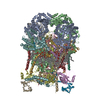
|
|---|---|
| 1 |
|
- 要素
要素
-タンパク質 , 8種, 16分子 AaBbCcDdEeFfGgJj
| #1: タンパク質 | 分子量: 58023.914 Da / 分子数: 2 / 由来タイプ: 天然 由来: (天然)  Tetrahymena thermophila SB210 (真核生物) Tetrahymena thermophila SB210 (真核生物)株: SB210 / 参照: UniProt: I7MGU2 #2: タンパク質 | 分子量: 53030.543 Da / 分子数: 2 / 由来タイプ: 天然 由来: (天然)  Tetrahymena thermophila SB210 (真核生物) Tetrahymena thermophila SB210 (真核生物)株: SB210 / 参照: UniProt: I7MJ25 #3: タンパク質 | 分子量: 50635.547 Da / 分子数: 2 / 由来タイプ: 天然 由来: (天然)  Tetrahymena thermophila SB210 (真核生物) Tetrahymena thermophila SB210 (真核生物)参照: UniProt: Q950Z1 #4: タンパク質 | 分子量: 37616.629 Da / 分子数: 2 / 由来タイプ: 天然 由来: (天然)  Tetrahymena thermophila SB210 (真核生物) Tetrahymena thermophila SB210 (真核生物)株: SB210 / 参照: UniProt: Q24IM5 #5: タンパク質 | 分子量: 30696.961 Da / 分子数: 2 / 由来タイプ: 天然 由来: (天然)  Tetrahymena thermophila SB210 (真核生物) Tetrahymena thermophila SB210 (真核生物)株: SB210 / 参照: UniProt: I7MIC7 #6: タンパク質 | 分子量: 9885.511 Da / 分子数: 2 / 由来タイプ: 天然 由来: (天然)  Tetrahymena thermophila SB210 (真核生物) Tetrahymena thermophila SB210 (真核生物)株: SB210 / 参照: UniProt: Q23K66 #7: タンパク質 | 分子量: 39193.523 Da / 分子数: 2 / 由来タイプ: 天然 由来: (天然)  Tetrahymena thermophila SB210 (真核生物) Tetrahymena thermophila SB210 (真核生物)株: SB210 / 参照: UniProt: Q23F81 #10: タンパク質 | 分子量: 5634.938 Da / 分子数: 2 / 由来タイプ: 天然 由来: (天然)  Tetrahymena thermophila SB210 (真核生物) Tetrahymena thermophila SB210 (真核生物) |
|---|
-Transmembrane protein, ... , 3種, 6分子 HhIiKk
| #8: タンパク質 | 分子量: 15677.771 Da / 分子数: 2 / 由来タイプ: 天然 由来: (天然)  Tetrahymena thermophila SB210 (真核生物) Tetrahymena thermophila SB210 (真核生物)株: SB210 / 参照: UniProt: I7M484 #9: タンパク質 | 分子量: 14262.554 Da / 分子数: 2 / 由来タイプ: 天然 由来: (天然)  Tetrahymena thermophila SB210 (真核生物) Tetrahymena thermophila SB210 (真核生物)株: SB210 / 参照: UniProt: I7MM45 #11: タンパク質 | 分子量: 7455.741 Da / 分子数: 2 / 由来タイプ: 天然 由来: (天然)  Tetrahymena thermophila SB210 (真核生物) Tetrahymena thermophila SB210 (真核生物)株: SB210 / 参照: UniProt: I7MFL6 |
|---|
-タンパク質・ペプチド , 1種, 2分子 lL
| #12: タンパク質・ペプチド | 分子量: 4850.612 Da / 分子数: 2 / 由来タイプ: 天然 由来: (天然)  Tetrahymena thermophila SB210 (真核生物) Tetrahymena thermophila SB210 (真核生物) |
|---|
-非ポリマー , 7種, 43分子 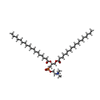

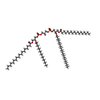

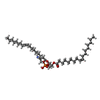
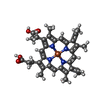
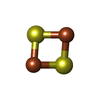






| #13: 化合物 | ChemComp-PC1 / #14: 化合物 | ChemComp-HEM / #15: 化合物 | ChemComp-CDL / #16: 化合物 | #17: 化合物 | #18: 化合物 | #19: 化合物 | |
|---|
-詳細
| 研究の焦点であるリガンドがあるか | Y |
|---|
-実験情報
-実験
| 実験 | 手法: 電子顕微鏡法 |
|---|---|
| EM実験 | 試料の集合状態: PARTICLE / 3次元再構成法: 単粒子再構成法 |
- 試料調製
試料調製
| 構成要素 | 名称: Dimeric cytochrome bc1 complex (complex-III2) / タイプ: COMPLEX / Entity ID: #1-#12 / 由来: NATURAL |
|---|---|
| 分子量 | 値: 0.64 MDa / 実験値: NO |
| 由来(天然) | 生物種:  |
| 緩衝液 | pH: 7.5 |
| 試料 | 包埋: NO / シャドウイング: NO / 染色: NO / 凍結: YES |
| 急速凍結 | 凍結剤: ETHANE |
- 電子顕微鏡撮影
電子顕微鏡撮影
| 実験機器 |  モデル: Titan Krios / 画像提供: FEI Company |
|---|---|
| 顕微鏡 | モデル: FEI TITAN KRIOS |
| 電子銃 | 電子線源:  FIELD EMISSION GUN / 加速電圧: 300 kV / 照射モード: FLOOD BEAM FIELD EMISSION GUN / 加速電圧: 300 kV / 照射モード: FLOOD BEAM |
| 電子レンズ | モード: BRIGHT FIELD / 最大 デフォーカス(公称値): 2600 nm / 最小 デフォーカス(公称値): 600 nm |
| 撮影 | 電子線照射量: 25.66 e/Å2 フィルム・検出器のモデル: GATAN K2 QUANTUM (4k x 4k) |
- 解析
解析
| CTF補正 | タイプ: PHASE FLIPPING AND AMPLITUDE CORRECTION |
|---|---|
| 3次元再構成 | 解像度: 2.8 Å / 解像度の算出法: FSC 0.143 CUT-OFF / 粒子像の数: 138746 / 対称性のタイプ: POINT |
 ムービー
ムービー コントローラー
コントローラー










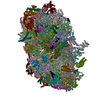
 PDBj
PDBj


